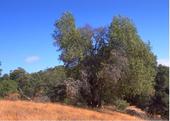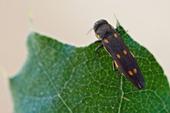- Author: Steven Swain

Sudden oak death (SOD) is a disease syndrome that has killed millions of native oak trees (Figure 1) along the west coast of the United States, from Big Sur in California up to Southern Oregon. The disease may involve several organisms, but its main driver is the fungus-like organism (known as water mold), Phytophthora ramorum. This plant pathogen is spread in the springtime by windy rainstorms. It infects the bark of oak trees, frequently creating bleeding trunk cankers that interfere with water uptake and sugar transport.
Death of SOD-infected trees can be accelerated by attacks from bark and ambrosia beetles. In the absence of beetle attacks, infected oaks may take years to die.
Many common...

There are several flatheaded boring beetles in California, however only a few are of particular concern. The goldspotted oak borer (GSOB), Agrilus auroguttatus, is a metallic wood-boring beetle that threatens our native trees. Since it was introduced to Southern California on contaminated firewood in the early 2000s, this pest has caused extensive damage to woodlands and native oaks.
What does the goldspotted oak borer look like?
Adult GSOB are 0.4 inch long and 0.08 inch wide with bullet-shaped bodies. They are black with an iridescent green sheen and six distinct gold spots on their back.
What damage does the goldspotted oak borer cause?
Goldspotted...
![Bark staining on coast live oak caused by larvae of the goldspotted oak borer. [Photo by Tom Coleman, USDA Forest Service]](https://ucanr.edu/blogs/UCIPMurbanpests/blogfiles/34690small.jpg)
Goldspotted oak borer. First identified in eastern San Diego County in 2004, the goldspotted oak borer, Agrilus auroguttatus, has killed over 25,000 California native red oaks since its arrival and has now been detected in Riverside County. Larvae feed deep within the phloem, and adults are rarely seen. Infestations are recognized by the presence of D-shaped exit holes on trees, often accompanied by bark staining and crown decline. There are currently no good ways to manage the pest in moderate to severely infested trees. Contact your agricultural commissioner if you find infestations outside the known infested area.
For more information on this pest, infestation zones, and ways you can help limit the...
- Author: Akif Eskalen
![Figure 4. Foamy liquid oozing from an infected tree. [A. Eskalen, UCR]](https://ucanr.edu/blogs/UCIPMurbanpests/blogfiles/31730small.jpg)
[From the August 2015 issue of the UC IPM Green Bulletin]
Declining coast live oak (Quercus agrifolia) trees have recently been found throughout urban landscapes in Los Angeles, Orange, Riverside, Santa Barbara, Ventura and Monterey counties. A fungus associated with a specific beetle is causing the decline by spreading what is known as “foamy bark canker disease” (Figures 1 and 2).
The fungal species, Geosmithia pallida, was recovered from symptomatic plant tissues in association with the western oak bark beetle...


